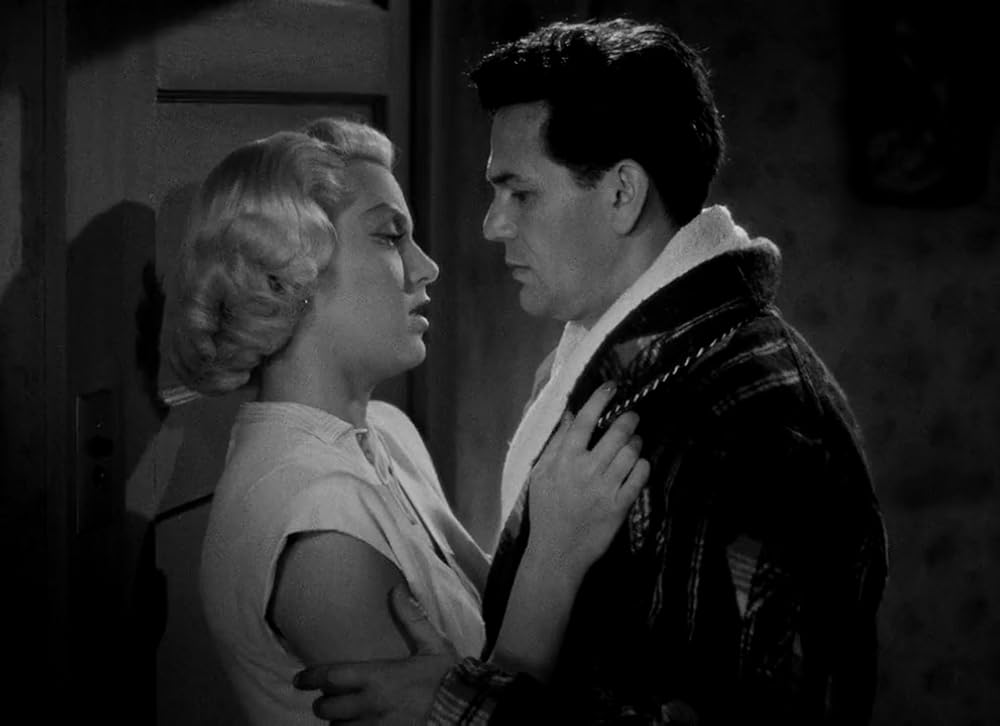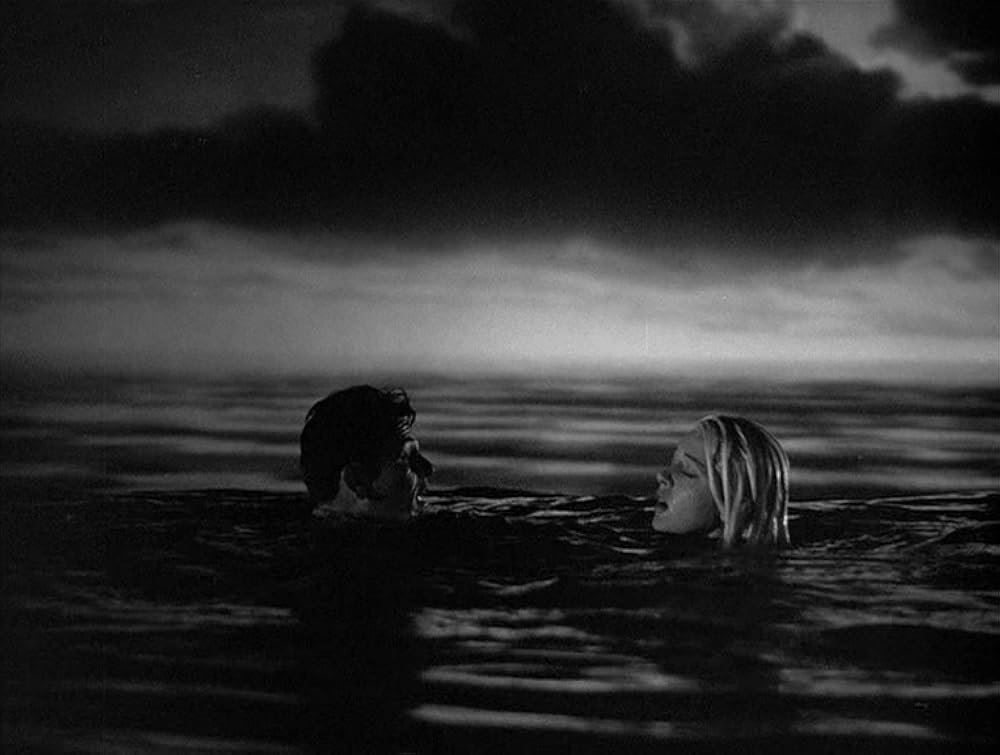my favorite movies of 1946:
(1) The Strange Love of Martha Ivers
(3) Notorious
(4) The Best Years of Our Lives
(5) The Postman Always Rings Twice
(6) Gilda
favorite of 1946:
The Strange Love of Martha Ivers
(Barbara Stanwyck, Van Heflin, Kirk Douglas, Lizabeth Scott, Judith Anderson. Directed by Lewis Milestone.)The Strange Love of Martha Ivers stands out from the typical film noir because of the way we start with kids (around 13 years old) on a pivotal stormy night. When the movie skips ahead to their adulthood, we have a richer sense of the characters as full human beings, haunted by a secret.
This movie is in the public domain, so you can watch the whole thing for free on YouTube:
You can also watch it on one of these other sites.
There are several fine performances in The Strange Love of Martha Ivers, but one that deserves particular attention is the late Kirk Douglas in the first movie of his long life. (He died at age 103 in 2020.) His character is a prosecutor who’s an alcoholic, and that role must have felt personal to him — his New York Times obituary says:
[His small hometown’s] mills did not hire Jews, so his father … became a ragman, a collector and seller of discarded goods. “Even … in the poorest section of town, where all the families were struggling, the ragman was on the lowest rung on the ladder,” Mr. Douglas wrote. “And I was the ragman’s son.” A powerful man who drank heavily and got into fights, the elder Demsky [the family’s real last name] was often an absentee father, letting his family fend for itself. Money for food was desperately short much of the time, and young Izzy [his childhood nickname] learned that survival meant hard work. … “That’s what it’s all about,” he said in describing what had driven him. “That’s the core, that early part of you.”The characters in The Strange Love of Martha Ivers wrestle with the question of whether “that early part of you” is what their lives need to be “all about.”
2nd favorite of 1946:
It’s a Wonderful Life(James Stewart, Donna Reed, Lionel Barrymore, Henry Travers, Thomas Mitchell, Gloria Grahame. Directed by Frank Capra.)This Chicago Tribune piece talks about how Jimmy Stewart’s PTSD after serving in World War II affected his performance in It’s a Wonderful Life.
After not having seen this movie in over a decade, I rewatched it around Christmas of 2020 (alone, because of the pandemic). I wanted to see if I’d still enjoy it enough to include it on this list of my favorite movies of each year — and not out of a sense of obligation just because it’s one of the most beloved American movies. I know the exact moment when I realized I had to put it on the list. I became so overwhelmed with emotion that I instinctively paused it, stood up, and walked around for a while to calm down. What had this effect on me? Two words …
In the video below, you can see “Awkward Ashleigh” reacting to watching the movie for the first time:
Stream It’s a Wonderful Life on these sites.
3rd favorite of 1946:
Notorious(Ingrid Bergman, Cary Grant, Claude Rains. Directed by Alfred Hitchcock.)Repressed emotion can be the most emotional of all.
This is the film, with “Casablanca,” that assures Ingrid Bergman’s immortality. She plays a woman whose notorious reputation encourages U.S. agents to recruit her to spy on Nazis in postwar Rio.From Criterion’s essay:
The performances by [Cary Grant and Claude Rains] are dynamic high-water marks in their towering careers. But even amid these wonders, it is Bergman who is the crowning jewel. She brings an untold warmth, a sincerity, and a vulpine physicality that make her character a beguiling outlier not only in Hitchcock’s canon but also within forties cinema and Bergman’s own career.Ebert:
Hitchcock’s “Notorious” is the most elegant expression of the master’s visual style. … It contains some of the most effective camera shots in his — or anyone’s — work.Criterion on that point:
Hitchcock and cinematographer Ted Tetzlaff are constantly reminding us where characters are in relation to one another, creating an intricate choreography in which even the most minute gestures — a hand enclosing a key, a gaze, a shaky grin — are charged with eroticism and violent potential.
You can stream Notorious on Tubi (it left but will likely come back) or these sites, but I recommend the Criterion blu-ray (or DVD). I admit I didn’t “get” this movie when I first saw it; what made it click for me was listening to the two commentary tracks on the Criterion blu-ray and then watching the movie again. Criterion movies are 50% off at Barnes & Noble every July and November, and Amazon often lowers prices in response.
4th favorite of 1946:
The Best Years of Our Lives(Dana Andrews, Harold Russell, Fredric March, Teresa Wright, Virginia Mayo, Myrna Loy, Hoagy Carmichael. Directed by William Wyler.)In the video below, Mel Brooks talks about how The Best Years of Our Lives “captured exactly what America felt in 1945, 1946”:
After the war, there was a lot of emotional disarray, and it was a healing picture. … It spoke to us deeply about the catastrophe we’d just gone through, and the need for us to make peace — not only in the world, but in our souls, and with each other.Ebert said:
Seen more than six decades later, it feels surprisingly modern: lean, direct, honest about issues that Hollywood then studiously avoided. After the war years of patriotism and heroism in the movies, this was a sobering look at the problems veterans faced when they returned home.Ebert summed up the video below:
One of the movie’s most famous sequences involves Fred [Dana Andrews] deciding to leave town in search of work, and going to the airport. While waiting for his military transport flight, he wanders into a vast graveyard of mothballed warplanes. This scene is heartbreaking. Once Fred flew these planes, and now they, and their pilots, are no longer needed. …
More from Ebert’s review:
“The Best Years of Our Lives” doesn’t use verbal or technical pyrotechnics. It trusts entirely in the strength of its story. One of the sources of its power is the performance by Harold Russell, the handless veteran. … [L]ook at the heartbreaking scene where [his character] Homer invites [his fiancé] Wilma up to his bedroom — not to make a pass, but to show her what is involved in getting ready for bed. He thinks maybe then she’ll understand why he doesn’t think he can marry her. …
Stream The Best Years of Our Lives on Amazon Prime, YouTube (free with ads), or these sites.
5th favorite of 1946:
The Postman Always Rings Twice
(Lana Turner, John Garfield, Cecil Kellaway, Hume Cronyn. Directed by Tay Garnett.)
When I first saw this classic film noir, I found it hard to get past its similarities to Double Indemnity (my favorite movie of 1944), starting with a man meeting an alluring blonde woman who feels trapped in her marriage and wishes her husband were dead. I enjoyed The Postman Always Rings Twice more on rewatch, when I set all that aside and focused on what makes it stand out: the dangerous chemistry between Frank (John Garfield) and Cora (Lana Turner); Cora’s mix of strengths and weaknesses, making her feel more like a real person than the typical “femme fatale”; the way the intricacies of the legal system can interfere with relationships; the exploration of the human capacity for rationalizing the unfathomable …
This video goes through “10 Golden Frames” from The Postman Always Rings Twice (with spoilers):
Stream The Postman Always Rings Twice on Tubi (free with ads) or these sites.
6th favorite of 1946:
(Rita Hayworth, Glenn Ford, George Macready. Directed by Charles Vidor.)
If you want to see perfect casting, look at Rita Hayworth (born Margarita Cansino) as the title character in Gilda. She gives an electrifying performance that blends wit and defiance with touching vulnerability. The “femme fatale” trope doesn’t do justice to this woman trapped by controlling men.
One of those men is her husband, Ballin Mundson (George Macready), who owns the casino the characters’ lives revolve around, with a similar vibe to Rick’s gin joint in Casablanca (my favorite movie of 1942). Before we ever see Gilda, Ballin has an odd meet cute with Johnny Farrell (Glenn Ford) when Ballin uses his “little friend” — a cane with a blade at the tip — to rescue Johnny from a robber. Somehow, that leads to Ballin delegating a surprising amount of responsibility to Johnny: not just running the casino but also keeping Gilda in line.
Gilda isn’t perfect — it’s too bad the narrator is Glenn Ford, who gives a more conventional, less exciting performance than Rita Hayworth. We’re hearing Johnny’s perspective while we’re really more interested in Gilda’s. The plot itself isn’t the movie’s strong suit, with intrigue that doesn’t quite jell and a laughably unsatisfying ending.
But I wouldn’t hold out hope for a remake to fix these shortcomings; in fact, Gilda would seem impossible to remake now. Today’s movies are blunt and in your face. In Gilda, we’re never shown all there is to see in the shadowy yet glittering underworld of the casino. Hollywood’s heavy censorship at the time meant that taboo ideas, like the sexual tension between the two men, had to be presented in a veiled way, not with too sharp a point — unless that sharp point was Ballin’s “little friend,” the cane/sword.
All this adds up to a beautiful mess of a movie driven by starkly noir-ish images, piercing stares, and tense standoffs where the line between love and hate is aggressively blurred.
Stream Gilda on these sites.
Click here for the full list of my favorite movie(s) of each year from 1920 to 2020.
.jpeg)




.jpg)







The story arc of Dana Andrews character is so compelling. A soda jerk elevated to a supremely heroic role as a combat pilot, only to being demoted back to a soda jerk.
ReplyDelete